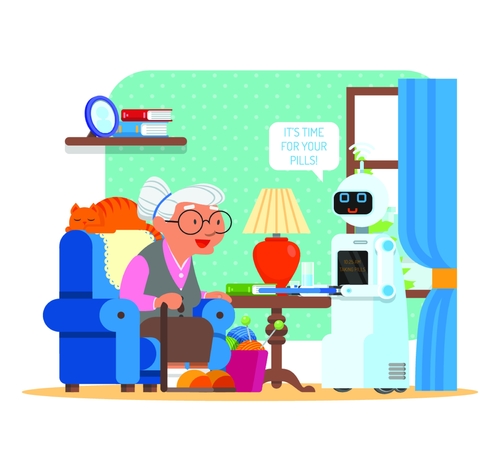
We’ve talked a lot about how robotic caregiving could greatly enhance a senior’s life and seems like a lot of other people agree. More research is being done on how to integrate technology into a senior’s life to allow them to be independent longer. The range of robotic caregiving is vast and could change a senior’s life.

Robotic Caregiving Research is Expanding
Remember our article about robotic pets? Well, that idea is expanding into more human-like robotic companions. Japan, in particular, has been looking into this possibility because their senior population is larger than their younger one. Having robotic caregivers can help supplement human caregivers and assist in not only menial tasks, but offer comfort to seniors as well.
Robotic pets are getting looked at more closely too. It’s been shown that they offer seniors comfort and emotional support. Even the U.S. Food and Drug Administration supports these robots because of the comfort they give. The problem is that these robots’ care are costly. They can cost around $6,400. Because of that, many people are trying to create less expensive versions so they can be more accessible.
Robots Aren’t As Cold As Most Think
While some people may believe there is no replacement for a human caregiver, they may be surprised at how well seniors and robots get along. In fact, some research has shown that robots, like a robotic pet, can encourage more social interaction in seniors. These robots can improve the overall mood in a room or in an individual to make them more friendly.
They are especially great for those with dementia. Often these robotic pets bring back memories of old pets they had and brings comfort to them.
Robotic Backup for Human Caregivers
The biggest help could be for caregivers. Robots can help with more physical tasks, allowing fewer accidents to happen. Even more so, they can support the mental health of the caregivers who often give their all to their aging loved one.
Laurel Riek, an Associate Professor of Computer Science and Engineering at the University of California San Diego, has been working with caregivers for a while. Riek and a team of scientists spent six months working with family members, caregivers, and social workers to create a robot to help with those who have dementia.
For those in the early stage of dementia, caregivers wanted robots that were in the background. They helped mediate interactions between caregiver and caregivee. In the later stages, caregivers wanted robots to be more active and offer caregivers a respite.
Riek and her team are now creating prototypes based on the robot designs the caregivers came up with and will be running tests soon.
Robotics Offering Independence
It’s not just in the caregiving field that robots and technology can be helpful in, they can also keep seniors independent longer. Tools like a robotic exoskeleton can help those with limited mobility to move easier. Creating smart homes can allow seniors to stay in their home longer. It can be simple things like voice recognition to turn lights on and off and other types of tasks. It can also be more depth with the house watching out for the senior to see there is anything wrong with them.
IBM Research U.K. is going to partner up with a British startup called Cera Care to do a six-month study on Lidar technology. Lidar technology is bounced laser tech that helps autonomous cars “see.” This can be used as a way to monitor someone without infringing on their privacy.
They will be putting these sensors in fifteen different houses to see if this technology, along with machine learning tools, could be helpful with keeping on eye on the senior’s health. The best part of all, once the sensors are set up, they don’t need any servicing.
Read more here.

